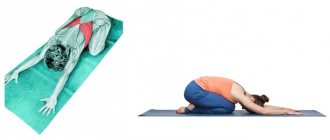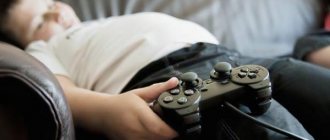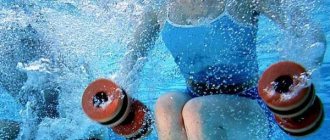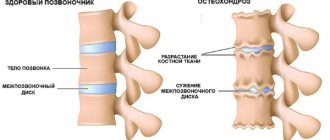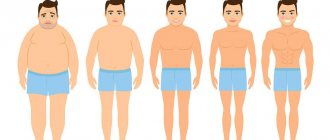Fighting obesity: first steps
Losing weight in obese people is not an easy process.
This is not just an improvement in external data according to the “golden formula” - eat less and move more.
One of the main aspects in the fight against obesity is strengthening the cardiovascular system and creating positive motivation for physical activity.
Marina Makarova, head of the exercise therapy department of the Center for Restorative Medicine and Rehabilitation of the Treatment and Rehabilitation Center of the Ministry of Health and Social Development of Russia, talks about where very overweight people should start exercising.
All roads lead to a doctor
Are you good and there are many of you?
Obesity is diagnosed when a body mass index (BMI) is 30 units or higher. Calculate your index using our BMI calculator, read about the diet for obesity, choose the appropriate exercises in the exercise database and find out why you should get rid of excess pounds in the first place.
If obesity of at least the second degree has already developed, then the fight against excess weight cannot consist only of increasing physical activity and reducing calorie intake. “The effect of a large number of extra pounds on the body does not simply go away,” notes Makarova.
It is necessary to increase physical activity under the supervision of a doctor . You will need an examination of the cardiovascular and respiratory systems, blood vessels of the extremities and the condition of the musculoskeletal system.
The data obtained will help determine whether it is worth increasing physical activity without restrictions. Otherwise, treatment and additional use of medications will be required.
Main muscle
Don't start a new life on Monday and study until you're exhausted. To begin with, an obese person needs training of the cardiovascular system , and only then – active burning of fats and strengthening muscles. After all, if the heart is not sufficiently trained, further increasing the load will only worsen its condition.
In addition, excess load and subsequent fatigue, pain in muscles and joints and increased appetite contribute to the appearance of a defeatist mood and refusal to try to get in good shape.
The simplest workout
A frequent companion to obesity is disturbances in the functioning of the cardiovascular system. Therefore, if problems with blood circulation do not affect the lower extremities, the maximum load in the form of walking is indicated to gradually improve heart function.
“In addition, walking, despite its apparent simplicity, is a very physiological activity,” says Makarova, “during which almost the entire body begins to work: not only the legs, but also the muscles of the back and arms.”
Start your workouts with a comfortable step. If you don’t yet have joint problems that , then you can walk almost indefinitely.
Despite the fact that walking is a cyclic load, consisting of repetition of the same movements, it cannot be called monotonous and boring. Even a walk through a familiar area of the city is always a new experience.
Carry on - with charging
strengthening muscles is recommended for obese people . First of all, the back muscles.
With excess weight and lack of load, they gradually lose the ability to support the spine, and the intervertebral discs have to support the body weight. This causes pain and discomfort. And it is because of them that an overweight person often refuses physical activity altogether.
The thigh muscles also need training to remove excess stress from the hip and knee joints, which can experience degenerative changes over time due to excess weight. Also spend time strengthening your gluteal and calf muscles.
If you want to go to the gym
Men are most often bored with gymnastics and prefer weight machines . But start classes after the approval of your doctor, and they should only take place under the strict supervision of the instructor.
Select the load in such a way that you can do at least 20 repetitions of one movement, and the classes last at least 45 minutes - then the cardiovascular system will also have time to get involved.
cyclic cardio training in your gym program . For example, on an exercise bike or elliptical trainer. After all, the first goal of physical activity in the fight against obesity is to improve the condition of the cardiovascular system.
The most important
Before increasing exercise, obese people should be examined by a doctor. Start your workouts with comfortable walking and light exercise that strengthens your muscles. You can also exercise in the gym, but under the supervision of a trainer and not forgetting about training the cardiovascular system.
An approximate complex of morning exercises for obesity
An approximate set of morning hygienic exercises for obesity
1. I. p. - main stand. Raise your arms up, stretch - inhale, return to i. p. - exhale. 3-6 times.
2. I. p. - the same. Spread your arms to the sides, raise your head up - inhale, return to i. p. - exhale. 5-6 times, average pace.
3. I. p. - the same. Walk in place with your hips high and your arms wide. Breathing is free, 1-2 minutes, average pace.
4. I. p. - standing, feet shoulder-width apart, hands on the belt. Circular movements of the pelvis to the right and left. 6-8 times. Do not hold your breath.
5. I. p. - standing, legs wider than shoulders, arms along the body. Bend your torso forward as much as possible, arms to the sides - exhale, return to i. n.—inhale. 5-6 times. The pace is average.
6. I. p. - lying on your back, legs straight, arms along the body. Bend your legs and spread them apart - inhale, return to i. p. - exhale. 6-8 times. The pace is average.
7. I. p. - the same. Spread your arms to the sides, bend your spine - inhale, return to i. n.—inhale. 3-5 times. The pace is average.
8. I. p. - the same. Spread your arms to the sides, alternately hug the knee of the bent leg, press it to your stomach - exhale, return to i. n.—inhale. 3-4 times. The pace is average.
9. I. p. - the same. Swing with a straight leg. Alternately with each leg. 4-6 times. Breathing is free.
10. I. p. - the same. Deep diaphragmatic breathing.
11. I. p. - the same, hands on the belt. Alternately bending your legs while lifting them off the floor (imitation of riding a bicycle). 10-12 times. Breathing is free.
12. I. p. - standing, legs together, hands on the belt. Jumping on toes to a height of 5-6 cm from the floor. Start with 10-12 jumps at a slow pace, followed by increasing the number and pace of jumps.
13. I. p. - standing. Energetic walking in a circle or in place with a gradual slowdown to a slow pace - 30 s.
14. I. p. - the same. Raise your arms up - inhale, relax them, lower them down, slightly tilting your torso forward - exhale. 4-5 times. The pace is slow.
Morning hygienic exercises can be replaced with a walk of 30 minutes to 1.5 hours, dosed walking or light jogging. After morning hygienic exercises, you should feel cheerful and improve your performance.
Therapeutic exercises can be done at any time of the day, but no later than 2 hours before bedtime, 1.5 hours before or after meals. During the warm season, it is advisable to perform it outdoors.
When selecting physical exercises, it is necessary to take into account that energy supply to muscle activity from fats occurs only when working at a certain intensity. An experiment conducted by specialists from the departments of anatomy, physiology and gymnastics of the State Central Institute of Physical Culture showed that rhythmic gymnastics classes for 45 minutes at a heart rate (HR) of 110-130 per minute did not affect the condition of fat and muscle tissue in the body of those involved , i.e. the fat layer did not decrease. And more intense work at a heart rate of 130-150 per minute for 10-14 minutes in a 45-minute session led to a decrease in adipose tissue. A beginner in therapeutic gymnastics will not be able to cope with such a load; it will take quite a lot of time for systematic physical exercise to increase physical performance. And only after the body has adapted to constantly increasing loads should submaximal loads be included in classes.
Morning exercises or hygienic exercises are performed immediately after sleep. It activates the activity of all organs and systems. Charging should always begin with walking at an average pace for 1-2 minutes. This is followed by exercises such as stretching: they help restore the rhythm and depth of breathing, as well as straighten the spine. After this, it is recommended to perform one or two exercises for the shoulder girdle, helping to consolidate the correct position of the head and shoulders. To develop and strengthen the muscles of the back and abdominals, you need to perform three or four exercises - bending, turning, rotating. Then several exercises for the lower extremities, including swings, squats, and jumps. Immediately after jumping, walking with a gradual slowdown in pace. After a set of morning exercises, it is recommended to carry out water procedures - wipe the body with a damp towel.
Each exercise is repeated 6-8 times. Morning hygienic exercises should not cause fatigue. The physical load on the body can be gradually increased by introducing more complex exercises, increasing the number of repetitions, or reducing rest intervals between exercises.
To prevent the exercises from becoming boring, after 7-10 days the complex is completely renewed or by gradually replacing 2-3 old exercises with new ones (until complete replacement).
Physiotherapy methods for obesity in children
Why can obesity occur at an early age?
The relevance of the problem of obesity is growing every year. In a number of European countries, every third child aged 6 to 9 years is overweight, and in some countries this figure reaches almost 40%. And every year the prevalence of excess weight is growing. There are many factors to blame for this.
First of all, an unbalanced diet (protein deficiency despite our time of abundance of goods in the store, an excess of simple sugars - confectionery, sweet drinks, etc.), also a decrease in physical activity. Especially during 2021 - quarantine, distance learning, forced isolation and stress-eating with sweets. Physiotherapy methods for obese children alone do not solve the problem of excess weight. But they can provide assistance during the period of treatment, as well as rehabilitation.
When it comes to excess weight, you need to remember that appearance is only part of the problem. Excess weight has a proven direct connection with cardiovascular diseases (arterial hypertension, impaired cholesterol metabolism, as well as the development of diabetes and cancer. Therefore, the problem must begin to be solved in childhood to ensure a healthy future for the child. First, build a balanced diet, taking into account age and food tolerance, form correct eating habits and this must be done by us - parents, not doctors or school teachers.
But the topic of dietetics and proper nutrition is voluminous and broad. We, taking into account the focus of our resource, will consider the possibilities of physiotherapy for obesity, as well as the main methods that can help both cope with the problem and a number of its consequences.
Physiotherapy methods for obesity in children
Frankly speaking, physiotherapeutic methods for obesity can indirectly influence the main cause. But this does not mean that nothing can be done at all. With the help of physiotherapy, we can enhance the metabolic process in tissues, influence the neuroendocrine mechanisms of regulation of the thyroid gland, and increase the adaptive mechanisms of respiration and blood circulation.
Physiotherapy for obesity can be prescribed from the age of 8 years.
The following techniques are used:
1. Light-thermal bath with a temperature of 55 – 60°C, 10 – 15 minutes, every other day, No. 15 – 20 (for nutritional obesity).
2. Electrical stimulation of the SMT of the rectus abdominis and thigh muscles. The electrodes are placed parallel to the rectus abdominis muscles. Type of work 2, frequency 30 Hz, 24 modulation depth 75 - 100%, current strength - until pronounced vibration appears. Then the muscles of both thighs are affected (alternately), the duration of the procedure for each field is 10 -15 minutes. Daily, No. 15 -20.
3. Phototherapy from the BIOPTRON device according to the scheme:
1. Impact on areas:
- coccygeal red light 2 minutes,
- sacred – orange light for 2 minutes,
- umbilical – yellow light for 2 minutes,
- frontal – blue light for 2 minutes.
If there are no color filters for the bioptron and only regular color is available, you can perform the procedure with regular color for 3 minutes per zone.
2. Apply to the eyes for 2 minutes: look at the switched on LEDs from a distance of 60 - 100 cm.
3. Apply yellow light on the feet and palms to the areas: kidneys, adrenal glands, spleen, liver, spine, prostate or ovaries, pancreas and thyroid glands. The course is 20 days, repeat once every 2-3 months.
Methods of exercise therapy and balneotherapy
4. Local douches, general rubdowns at a reduced water temperature.
5. Underwater shower-massage, pressure 1.5 atm, 10-25 minutes, every other day, No. 10.
6. Scottish shower for children over 12 years old: water temperature +40°C for 30 seconds, then 15 seconds +15°C, temperature change 3 times. Daily, 3 8 – 10.
7. Charcot shower - or circular shower, water temperature 30 - 20°C, 2 minutes, daily, No. 8 -10.
8. Shared baths:
- carbon dioxide +34°С + 30°С for 8 minutes,
- nitrogen +35°С +36°С for 10 minutes,
- iodine-bromine +36°С +37°С for 10 minutes,
- alkaline +36°С for 8 – 10 minutes,
- sulfide +34°С +36°С (concentration 0.05 g/l) for 8 minutes,
- shared baths according to Valinsky.
9. Half baths +32°C +28°C with dousing and vigorous rubbing, every other day, No. 15.
10. General wet wraps, the procedure lasts 40 minutes, daily or every other day, No. 8 -10.
11. Ural Federal District according to the general scheme.
12. Intestinal lavage 2 times a week, No. 4 – 6.
13. Exercise therapy, swimming in an open pond or pool, climatotherapy, health path.
14. General massage every other day, No. 10 to improve peripheral blood circulation.
15. Sauna while maintaining the function of the cardiovascular system.
DO YOU HAVE ANY QUESTIONS? GET ANSWER:
Physiotherapist, osteopath, rehabilitation specialist Karasenko V.P.
Bibliography: - Kuzmenko O.V. Methods of physiotherapy for obesity in children. — Aleksandrovich N.Zh., Rodnichenko N.N. The influence of swimming on the condition of young children. Issues of material protection, 1989, No. 10, pp. 66 -67. - Balneotherapy for diseases in childhood / Edited by T.V. Karachevtseva. - M., Medicine, 1980. - 445 p. — Weisfeld D.N. Physical and spa factors in the treatment of neurological patients. - K. Health. - 1988. - 192 p. — Galina I.V., Shterengerts A.E. Treatment and rehabilitation of children with cerebral palsy at a balneological resort. - K. - 1983 - 126 p. — Garbuzov V.I. Neuroses in children and their treatment. - L. - Medicine. - 1977 - 271 p.
Special physical exercises for poor posture, obesity, flat feet.
Municipal educational institution
additional education for children
"Center of children's creativity"
Leninsky district
Saratov
Correctional work with children
“Special physical exercises for poor posture, obesity, flat feet”
Compiled by the teacher:
Kretsul Ekaterina Vladimirovna
Introduction
In the modern world, with the advent of devices that facilitate work activity (computers, technical equipment), people’s physical activity has sharply decreased compared to previous decades. This ultimately leads to a decrease in a person’s functional capabilities, as well as various kinds of diseases. Today, purely physical labor does not play a significant role; it is replaced by mental labor. Intellectual work sharply reduces the body's performance.
But physical labor, characterized by increased physical activity, can in some cases be viewed from a negative perspective.
In general, a lack of energy expenditure necessary for a person leads to a mismatch between the activities of individual systems (muscular, skeletal, respiratory, cardiovascular) and the body as a whole with the environment, as well as to a decrease in immunity and a deterioration in metabolism.
At the same time, overload is also harmful. Therefore, both during mental and physical labor it is necessary to engage in special physical exercises.
Physical exercise has a healing and preventive effect, which is extremely important, since today the number of people with various diseases is constantly growing.
Physical culture should enter a person’s life from an early age and not leave it until old age. At the same time, the moment of choosing the degree of stress on the body is very important; an individual approach is needed here. After all, excessive stress on the human body, both healthy and with any disease, can cause harm to it.
Thus, physical culture, the primary task of which is to preserve and strengthen health, should be an integral part of every person’s life.
Special physical exercises for poor posture.
1. IP - standing. Adopting correct posture by touching the wall or gymnastic wall with the gluteal region, calf muscles and heels. Move 1-2 steps away from the wall, maintaining correct posture.
2. IP - lying on your back, arms along the body. The head, torso, and legs form a straight line. Raise your head and shoulders, return to IP.
3. IP - the same. In the correct position, press your lumbar region to the floor. Stand up and take correct posture.
Exercises to strengthen the muscle corset.
For the back muscles, IP - lying on your stomach, chin on the back of your hands, placed one on top of the other.
1. Place your hands on your belt, raising your head and shoulders, connect your shoulder blades, do not raise your stomach, and maintain the accepted position.
2. Raising your head and shoulders, slowly move your arms up and sides to your shoulders.
1. Raise your head and shoulders. Hands to the side. Squeeze and unclench your hands.
4. Alternately raising straight legs without lifting the pelvis from the floor. The pace is slow.
5. Raising both straight legs and holding for 10-15 seconds.
For the abdominal muscles, IP - lying on your back, the lumbar region pressed against the support.
I. Bend and straighten your legs at the knee and hip joints alternately.
I. Bend both legs, straighten forward, slowly lower.
.1. Alternate bending and extension of the legs without weight - “bicycle”.
4. Hands behind your head. Alternately raising straight legs forward. The same exercise and combination with different arm movements.
Corrective exercises.
Symmetrical. IP - lying on your stomach, chin on the back of your hands, placed one on top of the other, elbows apart, torso and legs straight,
1. Raise your arms up, stretch in the direction of your arms with your head without raising your chin, shoulders and torso. Return to IP.
2. Maintain the middle position of the spine, move your arms straight back; raise your legs, straightened at the knee joints - “fish”.
3. Raise your head and chest, raise your arms straight up, lift your legs straight, maintaining the correct body position, swing several times - “boat”.
Posture is of great importance in human life. Correct posture is a normal, healthy position of the spine, and it is known to be responsible for the functioning of all organs and systems of our body. Correct posture is not only a guarantee of health, but also a symbol of beauty, vitality and self-confidence. In our progressive age, every person pays more attention than ever to their appearance and maintaining their health. Therefore, today every person has a pressing need for knowledge on how to maintain their health using only their own strength, desire and time. There is no universal set of physical exercises to improve posture. This requires daily work on yourself, and it must be done consciously and skillfully. If you consciously monitor your posture today, that’s very good. Today I would like to draw your attention to the fact that you can’t just “maintain” your posture. You can also help your body with certain exercises, because... correct posture is not just a habit - it is the work of a certain muscle group. By strengthening them accordingly, we contribute to the consolidation of correct posture.
Special physical exercises for obesity:
1. Stand up straight, hands on your belt. Turn your body left and right, 5-6 times in each direction.
2. Stand up, arms to the sides. Lean forward and reach your left knee with your right hand and return to the starting position. Then, with your left hand, reach your right knee, return to IP. Repeat 5-6 times with each hand. After some time of practice, reach not your knees, but your toes.
3. Stand up straight, hands behind your head. Turn your torso left and right, 10 times in each direction.
4. Lie on your back, arms extended along the body. Raise your right leg up, press your knee to your stomach with your hands, and return to the starting position. The same with the left foot. Repeat 5-6 times with each leg.
5. The starting position is the same. Perform the exercise “bicycle” and “scissors”.
6. Lie on your back, hands behind your head. Raising your body, sit down and lie down again. Repeat 3-5 times. Legs straight.
7. Sit on the floor, stretch your legs. Leaning forward, try to reach your toes with your hands and touch your knees with your head. Repeat 5 times.
8. Stand up straight, arms down. As you inhale, slowly rise onto your toes, as you exhale, lower yourself onto your heels and squat slightly, without lifting your heels from the floor. Perform 10 times.
9. Perform 7-10 squats at a slow pace.
10. Walk with your knees high for 1 minute.
If desired, the exercises in the complexes can be changed or performed with dumbbells in your hands and feet.
In addition to special exercises, for obesity it is useful to do:
• Walking,
• Run,
• Ride a bike,
• Skiing,
• Skate,
• Do aerobics and swimming
Choose the sport that you like best - then you will enjoy doing it, and it will bring more benefits.
Obesity is manifested by increased deposition of adipose tissue in the body. Most often, the disease occurs due to excess nutrition of high-calorie foods containing fats and carbohydrates. This is primary obesity, nutritional, especially aggravated by low physical activity.
Obesity,
which manifests itself in diseases of the endocrine glands and the central nervous system (CNS) is called secondary.
Obesity is a risk factor for the occurrence of atherosclerosis, diabetes, and hypertension.
There are four degrees of primary obesity:
I degree - body weight is 15-29% higher than normal,
II degree - by 30-49%,
III degree - by 50-100%,
IV degree - more than 100%.
To calculate normal weight, Quetelet's weight-height index is most often used (height minus 100 corresponds to normal weight). At the same time, it is taken into account that at the age of over 30 years, body weight may be 2.5-6 kg more in men, 2.5-5 kg in women, especially taking into account the volume of the chest (narrow, wide, normal ).
Obesity is accompanied by various pronounced changes in the cardiovascular system, manifested by myocardial dystrophy, damage to blood vessels, heart, brain and lower extremities; a high position of the diaphragm and a decrease in its mobility leads to a decrease in the respiratory capacity of the lungs; the secretion of gastric juice increases; increased weight overloads the musculoskeletal system and, in combination with altered metabolism, contributes to the occurrence of arthrosis; physical performance decreases. With proper comprehensive treatment, including physical exercise and a rational diet, all manifestations of obesity disappear. Indications for prescribing physical therapy: primary and secondary obesity of degrees I, II, III, IV. They use morning hygienic gymnastics, therapeutic exercises, exercises on simulators, dosed walks on flat terrain and with climbs (health path), special exercises in the pool, swimming in open reservoirs, running, hiking, rowing, cycling, skiing, skating, moving and sport games.
Physical exercises for flat feet
.
Physical exercises for flat feet are aimed at strengthening the musculo-ligamentous apparatus of the foot. After gymnastics, you need to do warm foot baths for 10-15 minutes. The water temperature should not exceed 37° C. It is useful to add sea salt, chamomile or sage infusions to the water, and also dilute soap foam in it.
- Roll from heel to toe.
2. Turn your feet with your toes inward so that your big toes touch each other. Then turn them around so your heels touch. Don't lift your feet off the floor. 3. Pick up small objects, such as pencils, from the floor with your toes. 4. Use your toes to pull up a thin mat or towel. 5. Roll the ball with your feet. 6. Rest your hands on a chair. Raise your right leg and, counting to ten, make circular movements with your feet. Then repeat the same thing, but with your left leg. 7. Using the toes of your right foot, move from bottom to top along the lateral surface of the shin of your left leg. Then change the position of your legs. 8. Place your feet together. Bend and straighten your toes. 9. Raise your toes as high as possible. At the same time, do not lift your heels off the floor. 10. Walk barefoot on your toes without bending your knees. Keep your hands on your belt, move your elbows back, bend your back. 11. Walk first on your heels (while raising your toes as high as possible), and then on your toes. 12. Rise up onto your toes. Spread your heels apart, then bring them together and lower your entire foot. Repeat five times. 13. Spread your heels to the sides and rise onto your toes. Count to five and lower your entire foot.
14. Walk for a minute, rolling from your toes to your entire foot. Your legs should be slightly bent at the knees. 15. Slide the toe of your left foot forward, and at the same time rise onto the toe of your right foot. Then, sliding the toe of your right foot forward, simultaneously rise onto the toe of your left foot. 16. Rise on your toes and walk around the room with a springy step. 17. Walk on the outer edges of your feet, and then on the inner edges. 18. Place a rolling pin on the floor and stand on it for 30 seconds. 19. Standing on a rolling pin, do low squats while raising your arms to chest level. 20. Press your toes vigorously into the floor for 30 seconds. 21. Jog lightly on your toes for a minute. 22. Waltz. 23.Walk barefoot on a wool carpet.
Flat feet
- This is the flattening of the longitudinal and transverse arches of the foot. At the beginning of its development, it manifests itself in the form of increased fatigue of the legs when standing and walking, and later pain in the sole occurs, which is caused by sprained ligaments, joints and bone pressure on the nerve trunks. Pain can be transmitted to the lower leg, thigh and lumbar region.
Prevention of flat feet involves strengthening the muscles of the foot and its joint-ligamentous apparatus. If flat feet have developed, the doctor usually recommends an instep support (an orthopedic lining for shoes). However, wearing an instep support should be combined with corrective gymnastics for the foot, as well as self-massage, covering the lower limbs and especially the muscles of the foot and the inner surface of the lower leg. If you have flat feet, it is important to keep your feet perfectly clean. Tempering foot baths before going to bed are indicated. Shoes must be exactly the right size, the sole must be elastic and thick, the heel must be wide and low.
Conclusion
Thus, the health-improving effect of physical exercise is associated primarily with an increase in the body’s capabilities, the level of general endurance and ability to work.
An increase in physical performance is accompanied by a preventive effect in relation to risk factors for cardiovascular diseases: a decrease in body weight and fat mass, cholesterol levels, a decrease in blood pressure and heart rate.
In addition, regular physical training can significantly delay age-related involutional changes in physiological functions, as well as degenerative changes in organs and systems.
Performing physical exercises has a positive effect on the entire musculoskeletal system, preventing the development of degenerative changes associated with age and physical inactivity (impaired body functions with decreased physical activity). The mineralization of bone tissue and calcium content in the body increases, which prevents the development of osteoporosis (bone tissue degeneration with restructuring of its structure and rarefaction). The flow of lymph to the articular cartilage and intervertebral discs increases, which is the best means of preventing flat feet and posture.
All these data indicate the invaluable positive impact of special physical exercises on the human body.
Thus, we can talk about the need for physical exercise in the life of every person. At the same time, it is very important to take into account the state of a person’s health and his level of physical fitness for the rational use of the body’s physical capabilities so that physical activity does not cause harm to health.
10
Obesity and sports
And experts on television programs, and neighbors, and even doctors in clinics can sometimes give incredibly banal advice to overweight people - eat less, exercise!
And if you can’t argue with the first piece of advice on reducing food consumption, the second piece of common sense raises many questions.
Is it possible to exercise if you are obese? Are such exercises useful and how effective are they? Don't they do more harm than good for the body, which is burdened with excess weight? Let's try to figure it out by turning to the experience of French specialists and see what they advise.
Firstly, French doctors classify obese people as those who have a Body Mass Index above 30. For such people, physical exercise is selected strictly individually according to physical data, identified health problems, capabilities and specific goals. Therefore, it is completely unacceptable for a person who is overweight, and especially a significant “overweight,” to simply come to the gym and start working out either independently or in a group. Or suddenly start doing running exercises. The consequences can be too tragic - from worsening existing diseases and joint problems to death if there are concomitant cardiovascular diseases.
French doctors recommend seeking medical advice before starting physical exercise: only a doctor can identify all diseases and make recommendations on what kind of physical activity is permissible depending on the health status of each patient.
Then you need to decide on the type of acceptable physical activity. There are also not always obvious limitations here.
Thus, group sports classes, which are available in a regular fitness center, and which are positioned as aimed specifically at “burning fat”, as a rule, are not suitable for obese people, since they involve increased intensity, rhythm and speed of performing exercise elements. Therefore, you must first, together with the trainer, develop an individual training program, choose which exercises can be performed and with what intensity, so as not to harm the body.
In order to choose the right training program, you must also decide on the goals that a person sets for himself. And these goals should be completely achievable. For example, in the first few months, reduce your weight by 5 kg, reduce shortness of breath, improve the condition of your skin, feel that there are muscles in your body, etc.
You don’t have to immediately set a goal to lose several tens of kilograms or fit into clothes two sizes smaller.
This cannot be achieved quickly, but you can get upset and depressed from “failure”. When setting goals for yourself, you need to realize that at first there will be such a vicious circle - intense training is contraindicated for obesity - therefore, it will be ineffective - the weight will come off slowly. Nothing can be done about this. Be patient. Over time, with gradual weight loss and improvement in health, the intensity of training may increase, and subsequently their effectiveness.
Also, when choosing the type of physical activity, you need to take into account personal preferences and capabilities. There may not be a pool nearby, and you may find yoga boring. Yes, but then what type of physical activity should you choose? Here are some areas that can help you lose weight:
- Walking at a leisurely pace on a treadmill or in parks;
- Swimming, Aqua aerobics;
- Fitness exercises for various muscle groups, of moderate intensity, preferably on mats to avoid additional stress on the joints;
- Exercises on machines chosen by the trainer with reduced stress on the joints;
- Exercises with dumbbells;
- Bicycle (individually).
Attention! If you are significantly overweight, the following are absolutely contraindicated: high-intensity exercises, running, squats and jumping! A step platform is a rather dangerous device for overweight people - there is a risk of damaging the ankle joint. During any training, if you experience a feeling of shortness of breath, strong heartbeat, or dizziness, the training must be stopped immediately! It is always necessary to start your workout with a warm-up to warm up your muscles and avoid injury. Listen to your body so as not to harm it. Increase the load very gradually.
The next important point is the regularity of physical activity. It is advisable to do special exercises in the gym at least two to three times a week. On other days, practice walking as much as possible. A good combination of several types of loads.
So, the main thing is not to set yourself unattainable goals and start exercising little by little, regularly, and soon physical activity will become a part of your life, bringing joy and getting rid of extra pounds.
City Center for Medical Prevention
Currently, the World Health Organization considers obesity as a non-infectious epidemic; about 30% of the world's inhabitants are overweight. We asked Doctor of Medical Sciences, Prof. to talk about the connection between obesity and physical activity. St. Petersburg State Medical University named after. ak. I. P. Pavlov Mikhail Dmitrievich Didur.
Physical activity (PA) is any bodily movement produced by skeletal muscles that requires energy expenditure, including activity during work, play, household chores, travel and recreational activities. It is physical activity that is the determining factor in energy expenditure and is critical for energy metabolism and weight control.
Today, WHO defines everything related to human physical activity as a strict hygienic standard. And a person must observe this norm in the same way as body hygiene and diet. A pyramid of physical activity has been developed, which reflects all the necessary parameters of activity that allow maintaining physical health.
WHO experts determined that for people aged 18 to 60 years, the minimum level of organized physical activity should be at least 120 minutes per week, preferably 3 times a week for 40 minutes.
Important qualities
A person has five physical qualities: endurance, strength, flexibility, agility, speed. The first three are directly related to health indicators, with endurance determining 75-85% of health. The higher the quality, the higher the adaptive reserve and the level of somatic health, the more actively the body resists unfavorable environmental factors. Programs and standards have been developed that should develop and maintain endurance. Exercises of less than 20 minutes, and if you are overweight, less than 40 minutes, do not make sense.
This is walking at an average and fast pace, jogging, Nordic walking, cycling, rowing, exercise equipment, swimming, etc. It is better to exercise every other day, since endurance is maintained and developed if there is at least reinforcement than in 48 hours. If it was not there, it fades away. Once a person gains weight, all our endurance exercises should increase in duration and decrease in intensity.
Strength and Flexibility
In addition to endurance, a person must definitely train strength, devoting 60 to 80 minutes a week to strength training using exercise machines, dumbbells, and weights.
The third quality is flexibility. These are stretching exercises. The hygienic standard is at least twice a week for 20 minutes. Metabolism in muscle tissue occurs better when it has certain parameters of active and passive flexibility. This triad allows a person to maintain his body in order.
It is also necessary to note the quality of dexterity, which is associated with coordination parameters. It needs to be maintained in order not to fall into the icy conditions outside in winter. Dexterity is especially important for older people in order to be able to walk on slippery ice and correctly fall from their own height. After all, such falls lead to catastrophic consequences. People who are overweight also begin to lose this quality. Because the center of gravity shifts, various joints begin to be overloaded. Agree that it is easier for a person weighing 60 kg to hold himself in some position than for a person weighing 100 kg.
Weight loss
If you are overweight, you need to follow the “small steps” program. After all, obese people, as a rule, have impaired lipid metabolism, severe sedative stress, and overloaded joints. Therefore, by giving them loads, we seem to simultaneously increase the risk zone in many systems, ranging from cardiovascular, respiratory, etc.
Reducing body fat mass is a complex inert process. The body is very bad at parting with its fat accumulations. Therefore, all programs related to weight correction take from 6 to 15 months.
Losing more than 400 grams of body weight per week is considered non-physiological. You can, of course, lose more, but the health risks increase significantly. All the advertised “instant weight loss” is a whim!
About fat
Each cell saturated with fat has its own representation in the central nervous system. In the case when they want to deprive it of fat, it produces certain substances that take a person’s behavior out of control. Anyone who has ever wanted to lose weight quickly has experienced a state where literally their hands reach for food. This is the body’s struggle for the fat that it has accumulated.
Fat accumulates in a strange way in the body of every person. Obesity of the “pear” and “apple” type is known to everyone. But for some it is distributed over the lower extremities, for others it is deposited on the back of the head, etc. There are dozens of possible options. Today there is a lot of talk about epicardial fat, which accumulates in the area of the functioning heart. It is considered one of the markers of cardiovascular risk. And waist circumference is the number two predictor of cardiovascular events.
Waist circumference for men should be no more than 94-102cm,
for women - no more than 80-88 cm.
In order for fat to go away unnoticed, it takes time and perseverance, but not hype. After all, if a person with excess weight begins to move actively, this can lead to disastrous consequences.
Weight loss is a process
Competent weight loss is a therapeutic process that requires compliance with two rules: dosage and safety of exercise. You can't run a marathon without preparation! However, you should not give up physical activity immediately after the first weight loss failures. You just need to change the program every week.
The physiological cost of any exercise performed is very important to us. It is easily determined by instruments and gadgets that show the daily level of our activity. They are tuned to one movement - locomotion, as a kind of equivalent of a unit. Its analogue is the effort that a person expends to get up from a chair. The norm for such locomotion is 17-22 thousand per day. This is the lowest hygienic standard.
All non-communicable diseases in people are the result of their destructive lifestyle. Every person under 60 years of age can perform a simple test: go up the stairs to the 5th floor. If he came there with shortness of breath, coughing, wheezing, then this is a reason to think about his health. Shortness of breath is an important symptom for many diseases.
You can get information on your motor regimen from a doctor at a physical education clinic or in the rehabilitation departments of clinics. If we are talking about weight loss, then we must always remember that each person should have his own program, which takes into account his gender, age, level of health and physical fitness.
